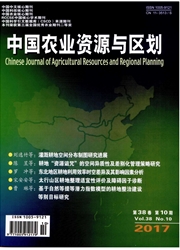

 中文摘要:
中文摘要:
科学评价当前中国农业碳循环情况、了解区域低碳竞争力是合理制定碳减排政策的重要前提。文章以我国2000~2011年31个省份的面板数据为样本,在综合农业碳循环过程中碳源和碳汇的双重特征来测算区域农业净碳量的基础上,通过构建农业低碳化评价指标体系得到低碳化指数,依据区域低碳化指数与农业经济发展水平对应情况,对不同时期的区域间的低碳竞争力进行分析。结果表明:近年来,区域农业净碳量的时空变化差异显著。从时间变化来看,2000~2011年全国各省(市、区)总的农业净碳量显著递增;从空间分布来看,东部沿海发达城市的净碳量高于全国平均水平;从各省低碳竞争力对比分析发现,人均农业GDP、低碳竞争力指数与地区经济发展水平之间具有明显的相关关系。且区域差异明显,东北地区呈现"低排放—高效益"型,西北、西南大片区域呈现"低排放—低效益"型,粮食主产区大多呈现"高排放—低效益"型,东部沿海发达地区大部分呈现"高排放—高效益"型。在科学量化农业碳循环的基础上,衡量区域间的低碳发展水平,可实现对低碳农业评价由定性描述向定量分析的转变。
 英文摘要:
英文摘要:
To scientifically evaluate agricultural carbon cycle and understand the regional low-carbon competitive-ness in China is premise to develop a reasonable carbon reduction policy. Based on the panel data of 31 provinces in China from 2000 to 2011 and the measurement of net carbon quantity in regional agriculture according to the dual characteristics of carbon source and carbon sink,this paper analyzed the low-carbon competitiveness of the various regions from 2000 to 2011 using the constructing low-carbon evaluation index system and the level of economic de-velopment situation of agriculture. The results indicated that the net carbon in regional agriculture showed significant spatial and temporal variations in recent years. The net amount of carbon was significantly increasing in 31 prov-inces from 2000 to 2011 . The spatial distribution showed that the net amount of carbon in eastern coastal cities was higher than the national average. Comparative analysis of low-carbon competitiveness among the provinces found that agricultural GDP per capita and low-carbon competitiveness index both had significant correlation with region-al economic development. And the low-carbon competitiveness of the various regions was different. The low-car-bon competitiveness showed multi-types,such as a type of "low emissions-high efficiency" in northeast China,a type of "low emissions-low efficiency" in most of Northwest and southwest areas,a type of "high emissions-low efficiency"in major Grain Production Regions of Chin,and a type of"high emissions-high efficiency" in most of the eastern coastal developed areas. To scientifically evaluate the low-carbon competitiveness of various regions can realize the transformation of from qualitative analysis to quantitative evaluation.
 同期刊论文项目
同期刊论文项目
 同项目期刊论文
同项目期刊论文
 期刊信息
期刊信息
